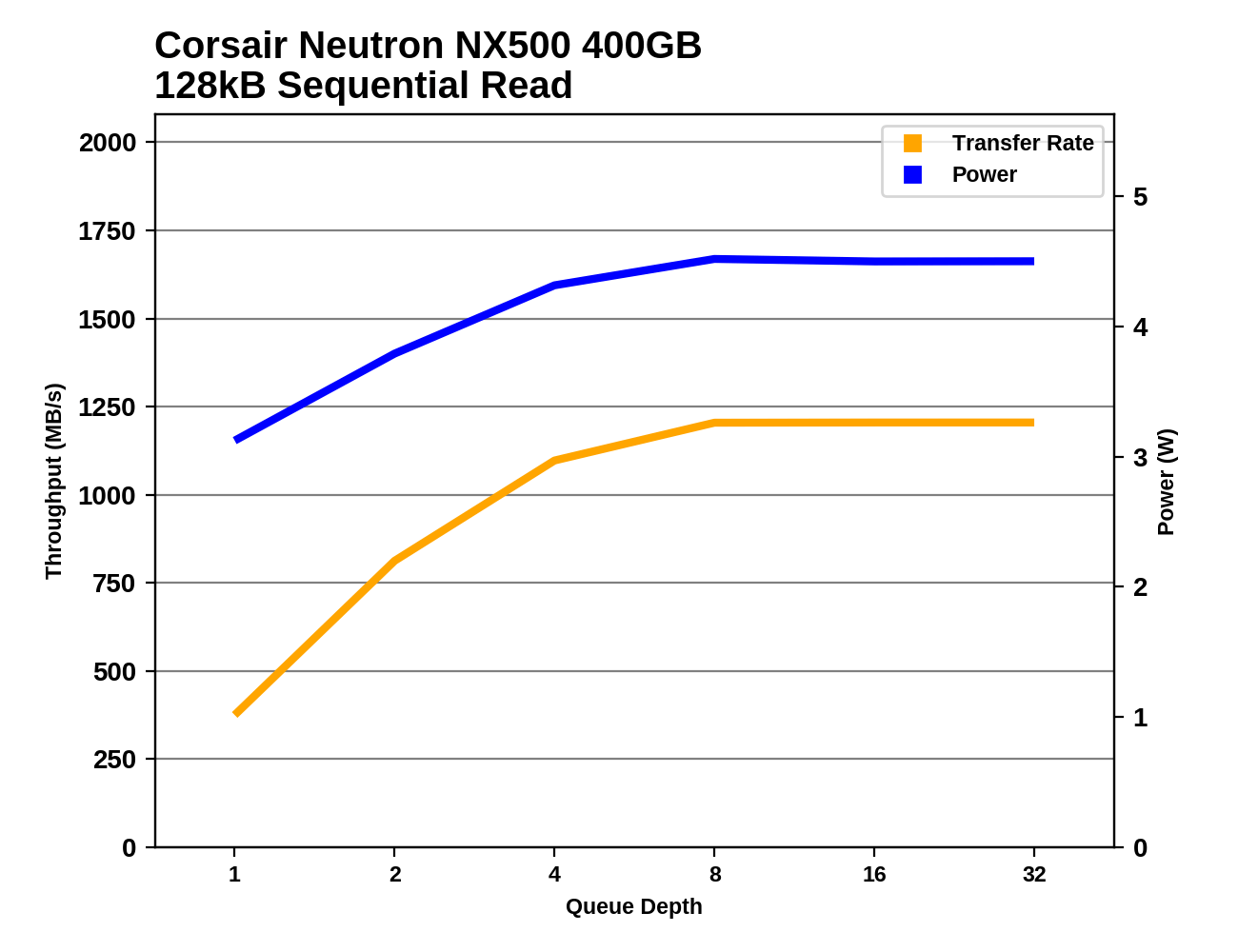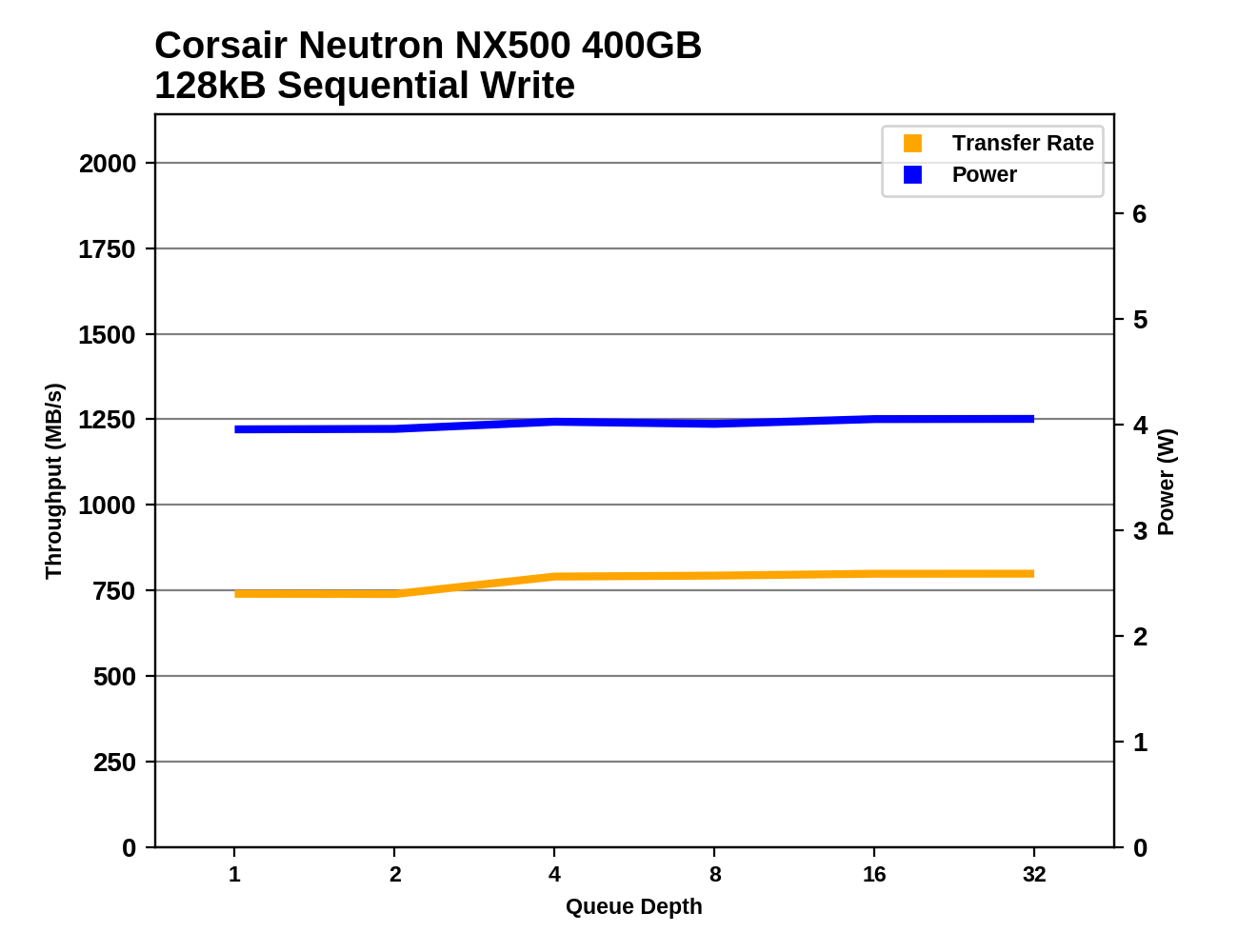The Corsair Neutron NX500 (400GB) PCIe SSD Review: Big Card, Big Pricetag
by Billy Tallis on August 16, 2017 10:00 AM ESTSequential Read Performance
Our first test of sequential read performance uses short bursts of 128MB, issued as 128kB operations with no queuing. The test averages performance across eight bursts for a total of 1GB of data transferred from a drive containing 16GB of data. Between each burst the drive is given enough idle time to keep the overall duty cycle at 20%.

The QD1 burst sequential read speed of the Corsair Neutron NX500 is a bit slower than the Patriot Hellfire, and quite a bit slower than the Plextor M8Pe. The Samsung NVMe drives are in a completely different league with QD1 read speeds more than twice as fast as any competitor.
Our test of sustained sequential reads uses queue depths from 1 to 32, with the performance and power scores computed as the average of QD1, QD2 and QD4. Each queue depth is tested for up to one minute or 32GB transferred, from a drive containing 64GB of data.

In the longer test that includes some higher queue depths, the NX500's sequential read speed is respectable and basically tied for the fastest non-Samsung drive in the bunch. It is also clearly faster than the other two Phison E7 drives.

The power efficiency of the NX500 during sequential reads is the best among the NVMe SSDs using planar NAND, and the other two Phison E7 drives follow the NX500 in the rankings. Samsung and Toshiba's 3D NAND NVMe drives offer much higher power efficiency.
 |
|||||||||
From QD1 speeds barely faster than a SATA link and half as fast as most NVMe competition, the NX500 eventually scales up to a decent saturation speed of around 1.2GB/s at QD8 or higher. Unfortunately, Samsung delivers better performance than this even at QD1, though the 960 EVO only barely so, and the 500GB version might not be quite as fast.
Sequential Write Performance
Our test of sequential write burst performance is structured identically to the sequential read burst performance test save for the direction of the data transfer. Each burst writes 128MB as 128kB operations issued at QD1, for a total of 1GB of data written to a drive containing 16GB of data.

The Corsair Neutron NX500's burst sequential write speed is the slowest of the three Phison E7 drives, but only barely and the performance is still decent for a planar NAND drive.
Our test of sustained sequential writes is structured identically to our sustained sequential read test, save for the direction of the data transfers. Queue depths range from 1 to 32 and each queue depth is tested for up to one minute or 32GB, followed by up to one minute of idle time for the drive to cool off and perform garbage collection. The test is confined to a 64GB span of the drive.

With a longer test, the Phison E7 drives hold on to their rankings though the NX500 is still the slowest of the three by a hair. Samsung's drives offer far higher sequential write speeds, but the rest of the competitors are clearly slower than the NX500.

The NX500's power efficiency during sequential writes is a bit worse than the Patriot Hellfire, but otherwise it is only beat by Samsung's NVMe drives. The next most efficient drive is the Toshiba XG5, which like Samsung's drives has the benefit of 3D NAND.
 |
|||||||||
The performance and power consumption of the Corsair Neutron NX500 during sequential writes barely changes with queue depth. The Samsung 960 EVO 1TB is more than twice as fast at QD2 or higher, so it is a very safe bet that even the 500GB version of the 960 EVO would have a significant advantage over the NX500 here.










45 Comments
View All Comments
damianrobertjones - Thursday, August 17, 2017 - link
Opens Amazon/ebay and types 'Toshiba XG5'. Nothing found. Oh well you've lost a possible sale Toshiba! Well done. (U.K.)mapesdhs - Thursday, August 17, 2017 - link
Get a 960 Pro instead, far better buy. My 512GB was only 249 UKP new.Or if you want to save some pennies, look for an SM951, SM961 or the older 950 Pro.
Billy Tallis - Thursday, August 17, 2017 - link
The XG5 is an OEM drive. They're selling every single one they can manufacture to companies like Dell. We'll see a retail counterpart eventually, once their BiCS3 manufacturing volume ramps up.wazoo42 - Thursday, August 17, 2017 - link
What happened to the performance consistency tests? Those were one of the primary reasons I went to Anand for SSD reviews.Billy Tallis - Thursday, August 17, 2017 - link
They'll be back eventually. I'm currently keeping the testbed busy around the clock with all the new drives that have arrived recently, plus re-testing older drives on the new 2017 test suite. The steady-state performance consistency test was the least realistic benchmark on the old 2015 test suite, so its replacement in the 2017 suite is my lowest priority. Once the testbed has some idle time, I'll go back and run the steady-state performance consistency tests on everything.In the meantime, the ATSB tests do have consistency scores in the form of 99th percentile latency, including broken down by reads and writes. I'm also considering adding some form of consistency score to the synthetic benchmarks that are already in this review.